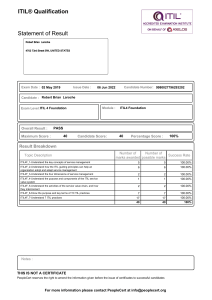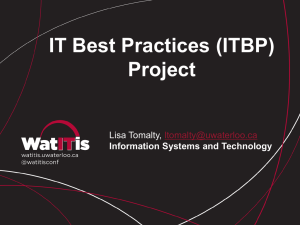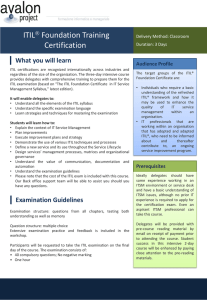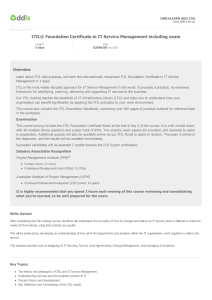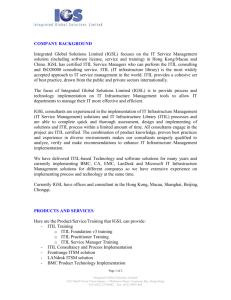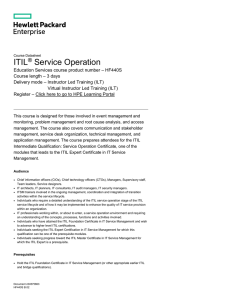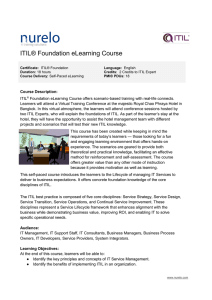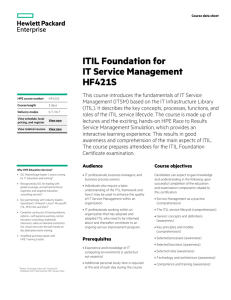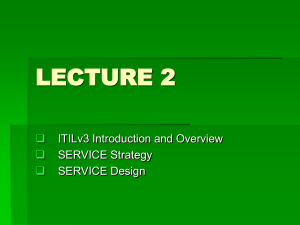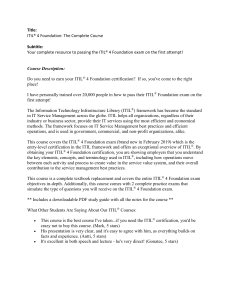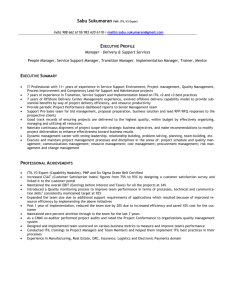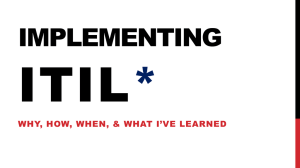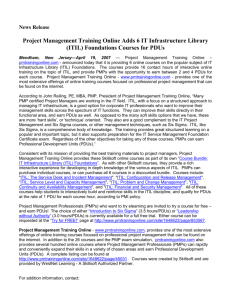Defining Some Basic ITIL Terms As you use ITIL for your day-to
advertisement
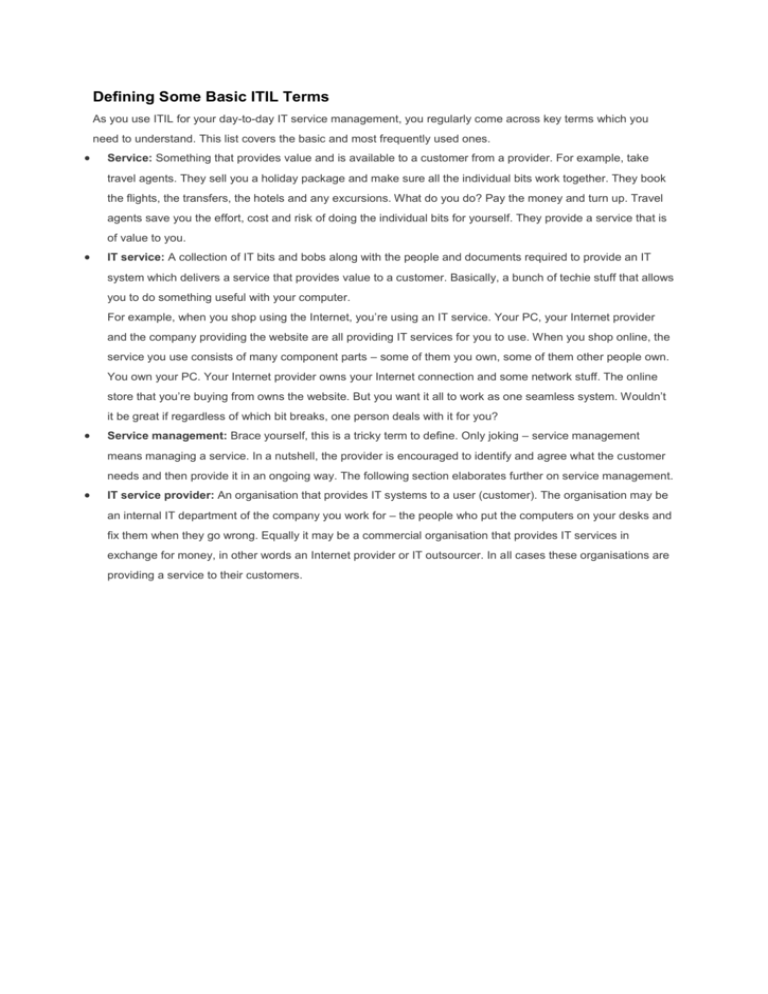
Defining Some Basic ITIL Terms As you use ITIL for your day-to-day IT service management, you regularly come across key terms which you need to understand. This list covers the basic and most frequently used ones. Service: Something that provides value and is available to a customer from a provider. For example, take travel agents. They sell you a holiday package and make sure all the individual bits work together. They book the flights, the transfers, the hotels and any excursions. What do you do? Pay the money and turn up. Travel agents save you the effort, cost and risk of doing the individual bits for yourself. They provide a service that is of value to you. IT service: A collection of IT bits and bobs along with the people and documents required to provide an IT system which delivers a service that provides value to a customer. Basically, a bunch of techie stuff that allows you to do something useful with your computer. For example, when you shop using the Internet, you’re using an IT service. Your PC, your Internet provider and the company providing the website are all providing IT services for you to use. When you shop online, the service you use consists of many component parts – some of them you own, some of them other people own. You own your PC. Your Internet provider owns your Internet connection and some network stuff. The online store that you’re buying from owns the website. But you want it all to work as one seamless system. Wouldn’t it be great if regardless of which bit breaks, one person deals with it for you? Service management: Brace yourself, this is a tricky term to define. Only joking – service management means managing a service. In a nutshell, the provider is encouraged to identify and agree what the customer needs and then provide it in an ongoing way. The following section elaborates further on service management. IT service provider: An organisation that provides IT systems to a user (customer). The organisation may be an internal IT department of the company you work for – the people who put the computers on your desks and fix them when they go wrong. Equally it may be a commercial organisation that provides IT services in exchange for money, in other words an Internet provider or IT outsourcer. In all cases these organisations are providing a service to their customers. Looking at Some Important Roles in ITIL Knowing who does what is essential to the success of ITIL. You benefit from knowing a few really important roles from the outset of your interaction with ITIL. The service owner The service owner owns a service. The service owner is usually someone in the IT provider organisation, and the role provides a point of contact for a given service. The service owner doesn’t necessarily know everything about the service, but he does know a man (or woman) who does. Here are some responsibilities of the service owner role: Participates in internal service review meetings Represents the service across the organisation Represents the service in change advisory board meetings Is responsible for continual improvement of the service and management of change in the service Understands the service and its components The process owner A process owner owns a process. This role is accountable for the process. For example, if the incident management process doesn’t achieve its aim of restoring the service to the user, the process owner gets shouted at (hopefully not literally). The process owner is accountable for the process and is responsible for identifying improvements to ensure that the process continues to be effective and efficient. Here are a few responsibilities of the role: Ensuring that the process is performed in accordance with the agreed and documented process Documenting and publicising the process Defining and reviewing the measurement of the process using metrics such as key performance indicators (KPIs) You must ensure that every service management process you adopt has a defined process owner. The process manager A process owner (see the previous section) is accountable for the process, but may not get involved in the dayto-day management of the process. This is a separate role often allocated to a different person: the process manager. A process manager is responsible for operational management of a process. The process manager’s responsibilities include planning and coordination of all activities required to carry out, monitor and report on the process. One process may have several process managers, for example it may have regional change managers or IT service continuity managers for each data centre. You must ensure that every service management process that you adopt has a defined process manager – though this may, of course, be the same person as the process owner. The process practitioner The process practitioner is the role that carries out one or many of the process activities. Basically, these people are the ones who do the work. However, it’s important that they have a clear list of responsibilities related to the process that they get involved in. Implementing Basic Service Level Management in ITIL If you don’t know what your customers need, you can never know whether you’re meeting their needs. It’s like fighting in the dark. You can never be right. (On the other hand, you can never be wrong – some people find this prospect attractive, but your customers won’t be impressed.) Service level management is, pretty obviously, the process that manages service levels. The process tries to set up a proper relationship with your customers and understand their business needs. Of course first you need to know who your customers are. If you’re the internal IT department that provides IT stuff to other people and departments within the same company, your customers are the business unit managers or department managers. If you’re a commercial IT services company providing IT services to other companies in exchange for money, your customers are those other companies; usually there is an assigned representative who talks to you. To implement service level management: Set up a dialogue with your customers Find out what they want Agree with them what you can provide Monitor and report on what you’ve achieved If you haven’t done this before, you’ll be surprised at the difference simply starting a dialogue with the business makes. In some cases the business will be amazed that you bothered to talk to it. If you’re open and honest and state your intentions up front, your customers will be happy to talk to you. ITIL also defines the process of business relationship management and the role of business relationship manager. The service level manager defines, agrees and reports on the service level for specific services – the business relationship manager maintains an overall relationship with the customer, keeps in contact, and looks for new opportunities to support the customer’s needs. Many organisations combine these roles into one job description. When setting up some basic service level management, you consider which roles you need. Applying the ITIL Service Lifecycle to IT Projects Understanding how ITIL works with real-world IT projects is crucial. Here’s a brief description of each activity of a typical project and its relation to the ITIL service lifecycle: Business case and project initiation: You use a business case to justify the cost and effort involved in providing the new service or changing an existing service. The business case triggers the project initiation. These activities happen at the service strategy stage. Requirements gathering and analysis: You identify and analyse the detailed requirements of the service or change. These activities happen in the service design stage. Design: You produce a design of the service that meets the requirements. This is usually a paper-based design at this point. These activities take place in the service design stage. Build: The physical bit where you acquire the solution, such as building the hardware, the servers and networks, or programming the software application. These activities happen in the service transition stage. Test: Testing the service is essential to ensure it meets the needs of the business, works in the way you expected, and can be supported. These activities also take place during the service transition stage. Implement or deploy: Launching the new or changed service into the live operational environment. This takes place during the service transition stage. Deliver and support: The service is now in the live or production environment and is being used by the users. The IT organisation must make sure the service is working and fix it quickly when it goes wrong. These activities take place during the service operation stage. Improve: After a service has been operated for some time, it’s often possible to optimise or improve the way it’s delivered. These activities are part of the CSI stage.

